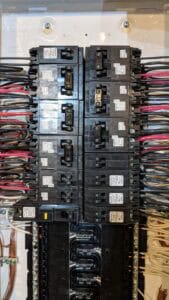Circuit breakers are one of the most important safety devices in every home or building. Without them, electricity would be far too dangerous to use. These small but powerful switches protect wiring, appliances, and people from overloads, short circuits, and other electrical faults. Understanding how circuit breakers work can help you recognize problems early and keep your Calgary home safe.
What Is a Circuit Breaker?
A circuit breaker is a safety device that automatically shuts off electrical flow when too much current passes through a circuit. When power surges, faults, or short circuits occur, the breaker “trips” to prevent overheating, fire, or damage to connected equipment. After the issue is fixed, the breaker can be reset, restoring power safely.
Every modern electrical system includes a main breaker that controls power to the entire home and smaller branch breakers that protect individual circuits. These breakers are located inside the electrical panel or breaker box.
Basic Principles Behind Circuit Breaker Operation
To understand how a circuit breaker works, it helps to know a few simple electrical terms:
- Voltage: The pressure that pushes electric current through a wire.
- Current: The flow of electrical charge moving through the circuit.
- Resistance: The opposition to the flow of current in a wire or appliance.
These three factors are related through Ohm’s Law, which states that voltage equals current multiplied by resistance. When voltage increases or resistance decreases, current flow rises. If too much current passes through a circuit, wires and components can overheat and fail. The circuit breaker’s job is to interrupt this flow before damage occurs.
How Electricity Flows Through Your Home
Electricity enters your home through the utility grid and passes through the main service panel. From there, it is distributed to various branch circuits that power lights, outlets, and appliances. Each circuit is designed to carry a specific maximum current, typically 15 to 20 amps for most residential wiring.
If a device or appliance malfunctions and starts drawing more power than the circuit can handle, the breaker detects the excess current and trips to the OFF position. This instantly stops the electrical flow, preventing wires from overheating and reducing the risk of fire.
What Causes a Breaker to Trip?
There are several common reasons why a breaker might trip:
- Overloaded Circuit: Too many high-demand devices running on the same circuit, such as space heaters, hair dryers, or kitchen appliances.
- Short Circuit: A direct connection between the live and neutral wires, often caused by damaged wiring or a faulty appliance.
- Ground Fault: When electricity escapes the intended path and flows into a grounded surface or object.
Each of these situations causes an unsafe rise in current. When that happens, the breaker’s internal sensor detects the surge and quickly disconnects the circuit to protect the system.
Thermal and Magnetic Protection
Most household circuit breakers use a combination of thermal and magnetic protection. Inside the breaker is a small bimetallic strip that bends when it heats up due to excessive current. When it bends far enough, it releases a spring-loaded switch that shuts off the circuit. In the case of a short circuit, a magnetic trigger responds instantly to the high current and cuts power in milliseconds.
This two-part design makes circuit breakers extremely reliable for both long-term overloads and sudden faults.
Safety Tips for Homeowners
Even though circuit breakers make electricity much safer, they are not maintenance-free. Here are a few tips to keep your home protected:
- Never reset a breaker repeatedly without identifying the cause of the trip.
- Keep your electrical panel easily accessible and labeled for each circuit.
- Do not overload power strips or run multiple high-power devices on one outlet.
- If a breaker feels hot, smells burnt, or won’t reset, contact a licensed Calgary electrician immediately.
When to Consider an Upgrade
Older homes in Calgary often have panels that are undersized for today’s electrical demands. If your system still uses fuses or a 60-amp service, consider upgrading to a 100-amp or 200-amp service upgrade. This ensures your circuits can handle modern appliances, electric vehicle chargers, and solar installations safely and efficiently.
Stay Safe with Professional Electrical Service
At Panel Upgrade Experts, we have been helping Calgary homeowners modernize their electrical systems since 2013. Our licensed electricians specialize in panel upgrades, breaker replacements, and electrical safety inspections. If your breakers are tripping frequently or your panel is outdated, contact us for a professional assessment and quote.
We will ensure your home’s electrical system is safe, efficient, and built to last for years to come.




